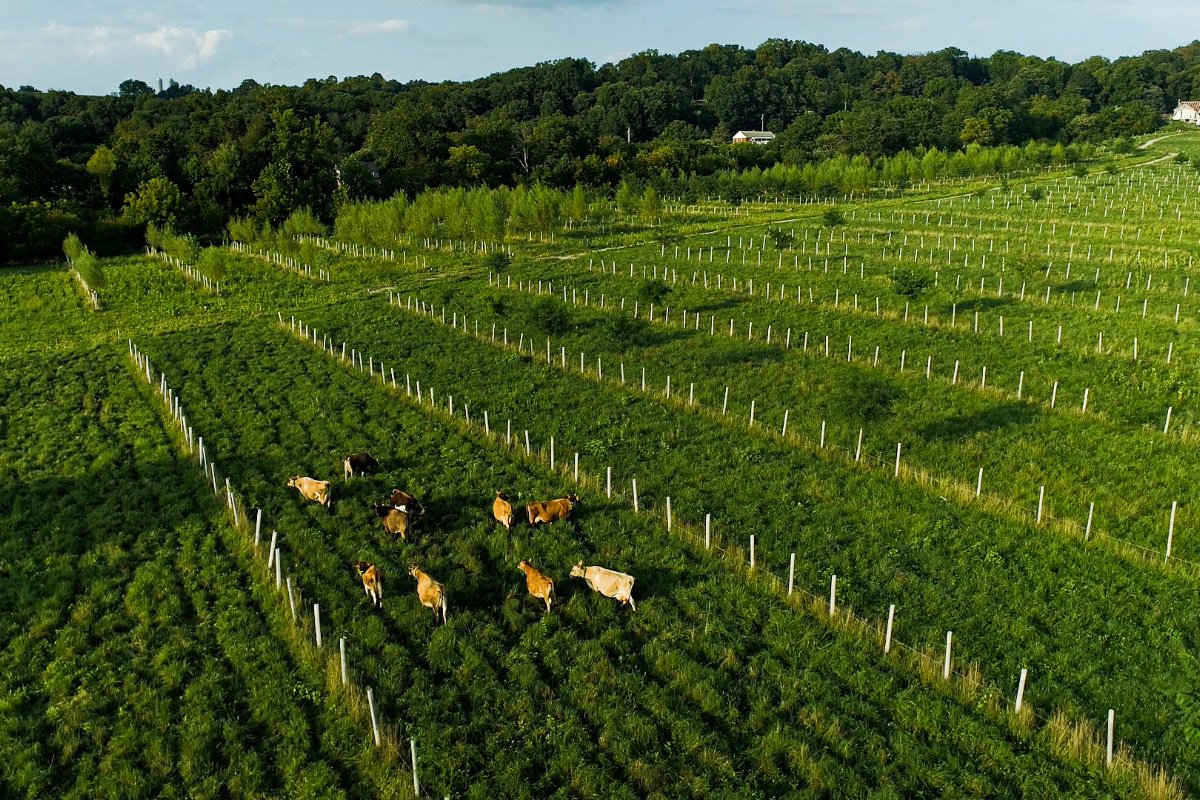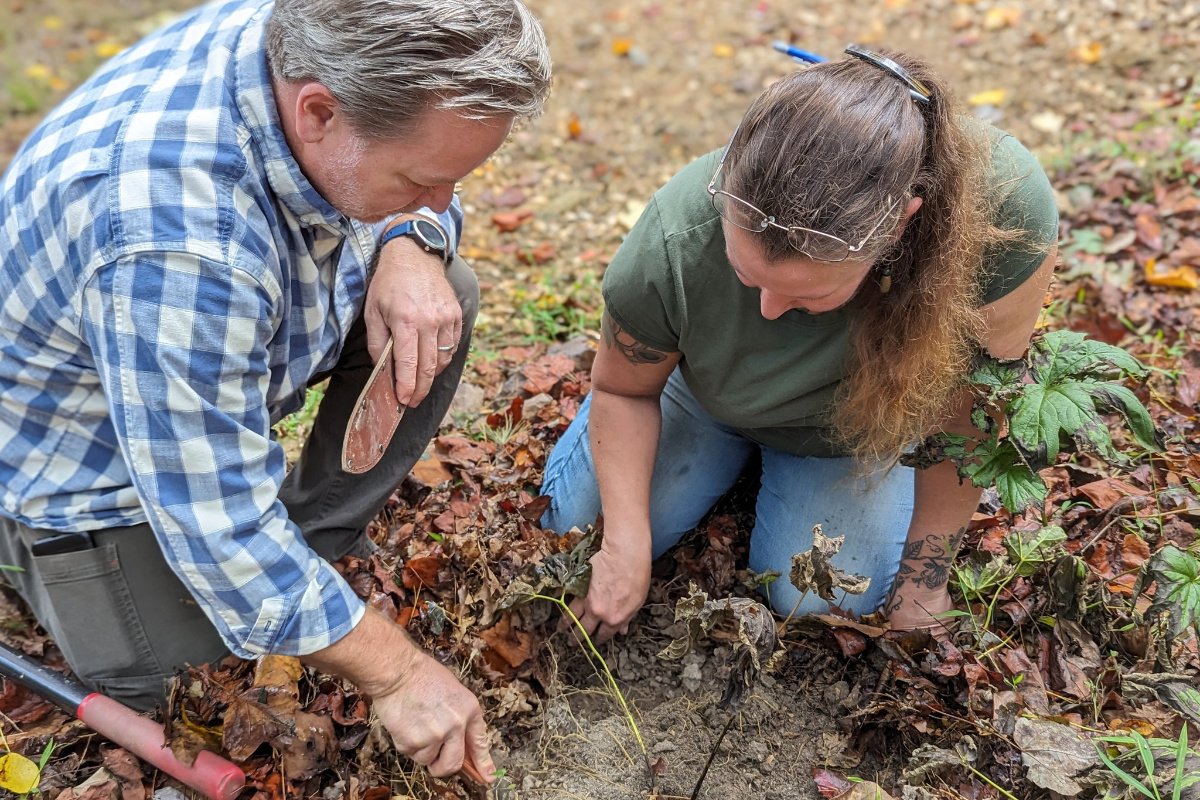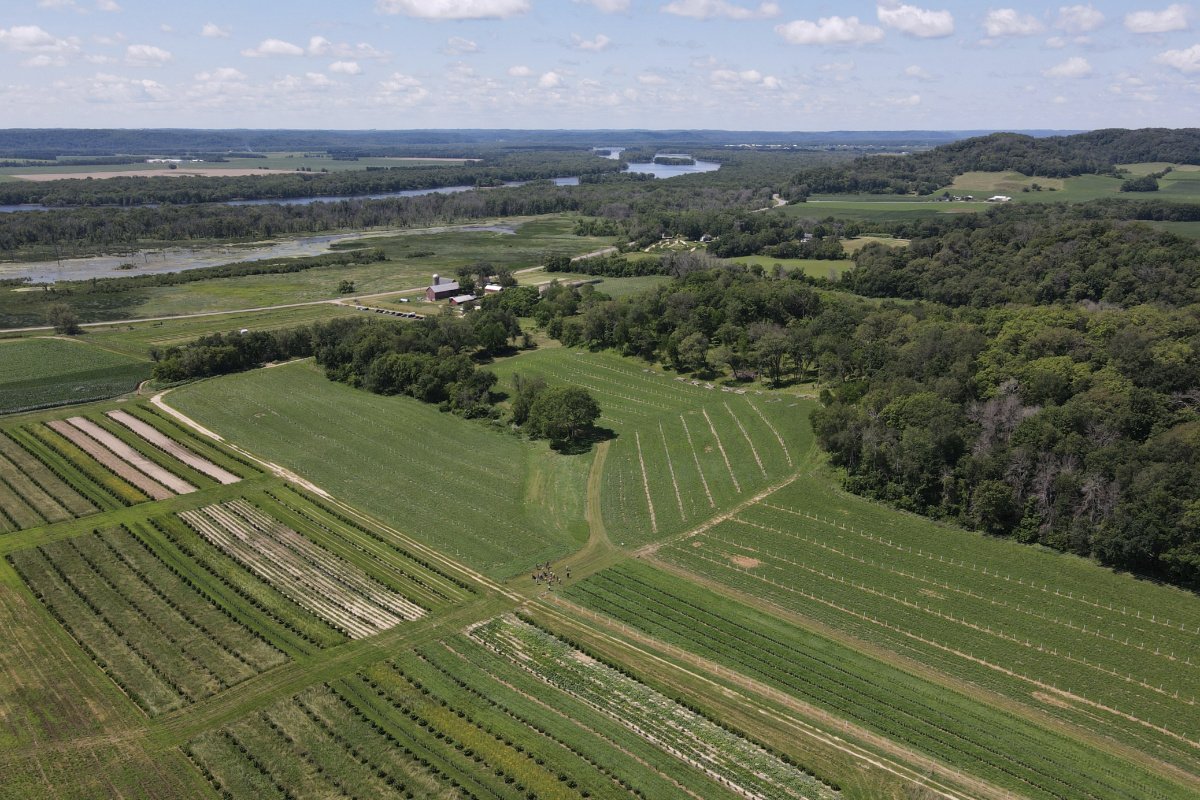Farming with trees at scale could buffer the impact of climate change. That work faces new obstacles as the USDA slashes funding.

Farming with trees at scale could buffer the impact of climate change. That work faces new obstacles as the USDA slashes funding.
April 28, 2025

Silvopasture farming in Pennsylvania. (Photo courtesy of the Savanna Institute)
A version of this article originally appeared in The Deep Dish, our members-only newsletter. Become a member today and get the next issue directly in your inbox.
Expand your understanding of food systems as a Civil Eats member. Enjoy unlimited access to our groundbreaking reporting, engage with experts, and connect with a community of changemakers.
Already a member?
Login
Austin Unruh is an advanced practitioner of patience. As the founder of Pennsylvania-based agroforestry business Trees for Graziers, he helps farmers plant saplings like honey locust, apple, and mulberry, which take years to reach their full potential.
While Trees for Graziers had been growing even before the Climate-Smart Commodities Program, 80 percent of the projects Unruh had planned for this spring were supported by those now-canceled funds.
“Everything just happens fairly slowly with agroforestry because of the nature of the beast—we’re working with trees,” he said.
Given enough time and care, Unruh continues, agroforestry—farming with trees—can become a keystone of resilient, profitable, and climate-conscious land management. In silvopasture systems like his, which bring trees onto pasture for livestock, cows can beat the summer heat under shade-giving honey locust trees while grazing on their seed pods. Besides keeping animals happier and lowering farmers’ feed costs, silvopastures can sequester carbon as the trees draw carbon dioxide from the air and, through their root systems, deliver it deep into the ground.
Other agroforestry practices such as windbreaks, hedgerows, riparian buffers, and alley cropping can help retain topsoil, prevent nutrient pollution, and provide wildlife habitat. According to the final installment of the United Nations’ Intergovernmental Panel on Climate Change (IPCC) Sixth Assessment Report in 2023, agroforestry is one of humanity’s most feasible options for reducing climate risks.
The USDA’s 2017 Census of Agriculture was the first to include a question about agroforestry. Over the next five years, the number of farms using agroforestry increased by 6 percent, even as the overall number of American farms fell by 7 percent. Practitioners formed a professional network, the Agroforestry Coalition, in 2022.
As Civil Eats has reported, the federal government gave agroforestry a major boost that same year through the USDA’s Partnerships for Climate-Smart Commodities program, awarding over $153 million to agroforestry work. Many of the organizations interviewed said the funds helped them hire staff, share knowledge, and implement agroforestry practices on thousands of farms.

An Appalachian Sustainable Development visit to a forest-farming site. (Photo courtesy of Appalachian Sustainable Development)
Unruh said that while Trees for Graziers had been growing even before the program, 80 percent of the projects he had planned for this spring were supported by Climate-Smart Commodities funds.
For nonprofits that support agroforestry, such as Virginia-based Appalachian Sustainable Development, the funding provided greater capacity for technical assistance and market development. Katie Commender, who directs the group’s agroforestry program, was working with one employee in 2020, trying to serve a backlog of hundreds of farmers who had requested site visits for agroforestry advice. Through Climate-Smart Commodities and other grants, she was able to hire four additional staffers and start whittling down the waitlist.
In January, when President Trump took office, that expansion began losing momentum. His administration froze already approved federal grant funding, including Climate-Smart Commodities grants. Farmers said they couldn’t pay for materials during the critical spring planting season, nonprofits began cutting the hours of their technical advisors, and experts were no longer able to attend events where they’d planned to share knowledge.
The administration received multiple court orders to lift the freeze; Secretary of Agriculture Brooke Rollins released $20 million for certain conservation initiatives in February, as well as an unspecified amount for rural energy work in March. Some USDA grant programs were fully unfrozen, while payments for others remain suspended.
An additional roadblock appeared earlier this month, when the USDA announced it would cancel the Climate-Smart Commodities program. While some projects may continue under a different name if they meet certain criteria, the program’s largest agroforestry grant—the $60 million Expanding Agroforestry Project (EAP), led by The Nature Conservancy—was decisively terminated. The future of other individual projects remains uncertain.
“The Partnerships for Climate-Smart Commodities initiative was largely built to advance the green new scam at the benefit of NGOs, not American farmers,” Secretary of Agriculture Brooke Rollins said in a press release announcing the cancellation.
An hour’s drive northwest from the White House, Sara Brown raises a herd of about 50 beef cattle on 200 acres in Lincoln, Virginia, that her family has owned since the early 1700s. This spring, as part of the EAP, she’d planned to start planting nearly 3,600 chestnuts and other trees across 30 acres of pasture. She hoped to add new forage options for her animals while retaining more water on her land, a concern given the area’s ongoing severe drought.
But after making arrangements to buy seedlings and prepare land, Brown learned in February that $225,000 in grant funding she’d been guaranteed was paused indefinitely. “I think I actually lost a couple of friendships that morning . . . people were in the crossfire of me being in a very bad mood,” Brown said with a rueful laugh.

Alley cropping at an agroforestry farm on the Wisconsin River. (Photo courtesy of the Savanna Institute)
She later learned that Trump’s newly established Department of Government Efficiency had canceled a contract with the Clark Group, a consultancy the USDA had hired to review her grant. And on April 14, The Nature Conservancy notified grantees that its agroforestry project had been terminated by the USDA.The money Brown had been counting on is now entirely off the table.
Brown said she’s still planning to plant some trees that she’d already acquired, but is unable to buy many more that had been scheduled to go in the ground this year. She’s paying out of pocket for deer fencing to protect those seedlings as well.
The funding uncertainty also upended technical assistance for farmers. Commender, with Appalachian Sustainable Development, said her team was working fewer hours, with 19 site visits currently on hold, to compensate for missing grant money; others at the nonprofit have been furloughed. Longer-term work to develop markets for high-value agroforestry products like elderberries, silvopasture-raised meat, and medicinal herbs is suspended indefinitely.
That kind of dedicated support is crucial for agroforestry because the practice is still relatively uncommon, said Keefe Keeley, executive director of the Savanna Institute, the Midwest’s leading agroforestry nonprofit. The organization has used federal money to scale up technical assistance staff in six Upper Midwestern states over the past several years, as well as develop demonstration farms.
Similar efforts were underway through over two dozen partners supported by the EAP grant alone. “Seeing a farm where something is happening and imagining how it could work on your own farm is really essential,” Keeley said. “The cancellation of these projects is undoubtedly a setback for farmers in our community who are getting ready to plant trees this spring. It means tens of millions of dollars in lost financial assistance for farmers who want to adopt agroforestry.”
Similar difficulties are occurring for agroforestry outside of the Climate-Smart Commodities program. San Carlos Apache Tribe member Stephanie Gutierrez, Ecotrust’s forests and Indigenous leadership program director, said Ecotrust was awarded over $2.5 million for that work.
The funds, from the American Rescue Plan Act in 2023, supported the Indigenous Agroforestry Network, which connects Native practitioners so they can share traditional and modern agroforestry techniques, including at an in-person meeting attended by many West Coast tribes last year. “The network brought them together to just share and listen and learn from each other,” she explains.
The grant was scheduled to cover work through 2027, and Gutierrez had been planning a new year of meetings and events when, in February, Ecotrust found itself unable to access federal reimbursement systems. Gutierrez said the organization was cut off from more than half of the money she’d been guaranteed. While Ecotrust briefly regained access the week of April 21, it was cut off again April 29. Federal officials haven’t shared any information about why the Indigenous Agroforestry Network has faced this inconsistency or when funding might be permanently restored.
Other agroforestry practitioners also say communicating with the USDA has been challenging, especially in light of the department’s recent staffing cuts. Keeley highlights layoffs at state-level Natural Resource Conservation Service offices, which have made it harder for farmers the Savanna Institute serves to access federal support. Some of those employees are returning after a court order reversed the layoffs of probationary workers, but the legal situation is unresolved.
The Agroforestry Coalition is particularly concerned about the USDA National Agroforestry Center and its 30 years of service. On April 2, the group delivered a petition to protect the center’s employees, signed by over 40 farmers and agroforestry organizations, to federal lawmakers from Nebraska, where the office is based.
“Seeing a farm where something is happening and imagining how it could work on your own farm is really essential.”
The USDA office represents the only dedicated voice for agroforestry in the federal government, said Cristel Zoebisch, who co-chairs the coalition’s policy working group. While the Trump administration hasn’t yet cut the center’s staffing, she said it’s a likely target for future layoffs.
“We wouldn’t have anyone within the USDA that’s focused on figuring out how agroforestry might fit under different federal programs, advocating for that, and providing that information to stakeholders,” Zoebisch said of what might happen if the center is shuttered.
Back in Pennsylvania, Unruh said he’s largely been able to pivot from the Trees for Graziers projects that had been supported by Climate-Smart Commodities, thanks in part to community connections and the local interest in agroforestry. “It wasn’t a surprise, and we had been functioning under the assumption that the money would not come back,” he says of the cancellation news.
Other practitioners may not be so fortunate. Unruh said many farmers taking their first chance on trees are facing significant bills, now with no chance of federal reimbursement. He’s not optimistic that the administration will adopt the long-term thinking needed to promote agroforestry; instead, he hopes that farming with trees will spread organically as the benefits continue to prove themselves.
“We’re here to support small farms, family farms, and that’s language that everyone can get behind. This isn’t just about climate change,” he said. “It’s about seeing more small farms thrive.”
This story has been updated to reflect the most recent information from Ecotrust regarding funding.

July 30, 2025
From Oklahoma to D.C., a food activist works to ensure that communities can protect their food systems and their future.
Like the story?
Join the conversation.